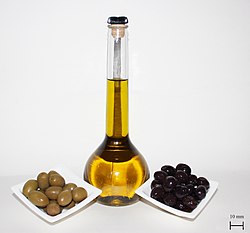Olive oil

Extra-virgin olive oil presented with green and black preserved table olives
|
|
| Fat composition | |
|---|---|
| Saturated fats | |
| Total saturated |
Palmitic acid: 13.0% Stearic acid: 1.5% |
| Unsaturated fats | |
| Total unsaturated | > 85% |
| Monounsaturated |
Oleic acid: 70.0% Palmitoleic acid: 0.3–3.5% |
| Polyunsaturated |
Linoleic acid: 15.0% α-Linolenic acid: 0.5% |
| Properties | |
| Food energy per 100 g (3.5 oz) | 3,700 kJ (880 kcal) |
| Melting point | −6.0 °C (21.2 °F) |
| Boiling point | 700 °C (1,292 °F) |
| Smoke point | 190 °C (374 °F) (virgin) 210 °C (410 °F) (refined) |
| Solidity at 20 °C (68 °F) | 1,000 °C (1,830 °F) |
| Specific gravity at 20 °C (68 °F) | 0.911 |
| Viscosity at 20 °C (68 °F) | 84 cP |
| Refractive index | 1.4677–1.4705 (virgin and refined) 1.4680–1.4707 (pomace) |
| Iodine value | 75–94 (virgin and refined) 75–92 (pomace) |
| Acid value | maximum: 6.6 (refined and pomace) 0.8 (extra-virgin) |
| Saponification value | 184–196 (virgin and refined) 182–193 (pomace) |
| Peroxide value | 20 (virgin) 10 (refined and pomace) |
| Nutritional value per 100 g (3.5 oz) | |
|---|---|
| Energy | 3,699 kJ (884 kcal) |
|
0 g
|
|
|
100 g
|
|
| Saturated | 14 g |
| Monounsaturated | 73 g |
| Polyunsaturated | 11 g
0.8 g
9.8 g
|
|
0 g
|
|
| Vitamins | |
| Vitamin E |
(93%)
14 mg |
| Vitamin K |
(57%)
60 μg |
| Minerals | |
| Iron |
(4%)
0.56 mg |
|
|
|
|
|
| Percentages are roughly approximated using US recommendations for adults. Source: USDA Nutrient Database |
|
Olive oil is a liquid fat obtained from olives (the fruit of Olea europaea; family Oleaceae), a traditional tree crop of the Mediterranean Basin. The oil is produced by pressing whole olives. It is commonly used in cooking, whether for frying or as a salad dressing. It is also used in cosmetics, pharmaceuticals, and soaps, and as a fuel for traditional oil lamps, and has additional uses in some religions. It is associated with the "Mediterranean diet" for its possible health benefits. The olive is one of three core food plants in Mediterranean cuisine; the other two are wheat and grapes.
Olive trees have been grown around the Mediterranean since the 8th millennium BC. Spain is the largest producer of olive oil, followed by Italy and Greece. However, per capita consumption is highest in Greece, followed by Spain, Italy, and Morocco. Consumption in North America and northern Europe is far less, but rising steadily.
The composition of olive oil varies with the cultivar, altitude, time of harvest and extraction process. It consists mainly of oleic acid (up to 83%), with smaller amounts of other fatty acids including linoleic acid (up to 21%) and palmitic acid (up to 20%). Extra-virgin olive oil is required to have no more than 0.8% free acidity and is considered to have favorable flavor characteristics; it forms as much as 80% of total production in Greece and 65% in Italy, but far less in other countries.
...
Wikipedia
